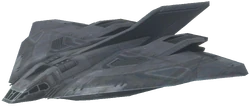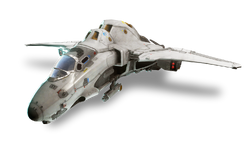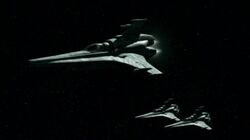| This fanfiction article, Vindication-class light battleship, was written by Sev40. Please do not edit this fiction without the writer's permission. |
| This article, Vindication-class light battleship, was written by Sev40, but may be used freely by other users even without the author's explicit permission. |
| This is a fanon expansion of a canon element. To see the original canon article, follow the link to Halopedia: Vindication-class light battleship. |
| The author, Sev40 urges and gives permission for any user who references this unit or vessel, Vindication-class light battleship, to add their article to the "Known" list below. |
| |||||||||||||||||||||||||||||||||||||||||||
| [Source] | |||||||||||||||||||||||||||||||||||||||||||
- "She's fast, and packs a hell of a punch without being too easy to break like a battlecruiser. I don't know if she can 'vindicate' a Valiant, but there's no doubt she'll be a hundred times more reliable in our fight."
- ―Anonymous naval assessor, on the UNSC Vindication.
The Vindication-class light battleship (hull classification symbol: BB) is a line of medium capital ships that is utilised by the UNSC. Built during the late-Covenant war, the Vindication is intended to be the answer to the Covenant Empire's formidable line of heavy capital ships, and in groups defeat the prestigious CAS-class assault carriers. Equipped with the heaviest array of missiles, MACs and the second-thickest hull ever fitted onto a ship of its size, the Vindication is an insurmountable obstacle to most smaller Covenant vessels and is often used as a flagship for UNSC fleets.
The Vindication was originally developed as a replacement for the Valiant-class large cruiser during the Insurrection, justifying its long and costly development by exaggerating the threat of stolen capital ships. Eventually being introduced in 2518, they would be adapted into high-priority escorts for carriers and flagships of very-large battle groups. Even here, rising costs, as well as a lack of targets that required its attention, saw the entire line risking decommissioning until the Covenant arrived. Proving to be one of the few ships capable of taking on multiple larger warships, they would become the cornerstone of the very largest colonial defence fleets. Consistently updated throughout the war at the expense of Aerofabrique SA, few Vindication-class battleships survived the war. Nevertheless, refinements to their design and Aerofabrique lobbying saw the UNSC restarting production of these formidable warcraft, and would rise to fulfil the role of a general capital ship in their reformed fleet. That they are one of only two ships to be allowed to stay in production is a testament to their impressive capabilities, and it is believed they will be protecting the UNSC's interests for much of the foreseeable future.
Layout
Role
As the definer of the modern battleship genre, the Vindication-class light battleship is primarily built as a heavy fire-support unit that is capable of going toe-to-toe with almost any attacker. This includes threats that are just as large if not bigger than the battleship, a weakness that plagued competing battlecruiser models. Its anomalously thick armour is reinforced with composite materials, allowing it to resist impacts that would normally gut heavy cruisers. This lends itself well to acting as a mobile stronghold, as it is the smallest warship where it is preferable to take hits rather than wasting fuel to dodge it. Most of its firepower is locked up within devastatin weapons, including three cruiser-grade MACs, dozens of fusion missiles, and batteries of naval coilguns. All of these excel at defeating other capital ships, having the necessary force behind them to overwhelm their defences.
As a holdover from the needs of the Insurrection, the Vindication-class is built as a pursuit vessel; it is for this reason that it is occasionally classified as a 'fast battleship.' Even light cruisers find it difficult to outpace it in the immediate short-term, with short bursts of rapid acceleration possible through two supplemental thrusters. Another notable difference is that while capable of operating alone in battle, it is best used in pairs attached to a heavy carrier, where it shares a symbiotic relationship that directly address their core weaknesses.
Specifications
Complement
While the Vindication-class is supposed to prioritise firepower over the arguably more resilient fighter craft, in reality, history has proven that modern point-defence technology is unable to offer the same defensive capabilities as space fighters that are deployed to intercept attackers. While this is the biggest reason for their inclusion, they have other benefits, such as acting as a mobile sensor screen around the battleship, improving the firing solutions of its long-range naval coilguns, and conducting planetside attacks as a smaller-scale alternative to planetary bombardment. As a result, even when reversed-engineered pulse laser turrets become cheap enough to replace tradition point-defence guns, it is likely that bureaucracy will remain steadfast in their requirement for all large-capital ships to have their own strikecraft complement. All fighter craft on these battleships fall under the jurisdiction of the UNSC Air Force rather than Naval Aviation.

|
| The C712, the smaller and more resilient of the two Longsword models in service. |
Even after the introduction of more advanced strike fighters and bombers, the Vindication's hangars are dominated by various models of GA-TL1 Longsword. A true multirole platform, in its original configuration the Longsword is designed to fulfil the roles of dogfighting, interception, bombing, ground attack and reconnaissance, in equal effectiveness. In addition, it requires minimal modifications to in an electronic-warfare, scout, and even a troop transport role when dropships are unavailable. It is well balanced between speed and durability, although it has a particular focus on offensive potential through its weapons payload. Interestingly, its delta-shape is well-suited to both reducing the RADAR cross-section of the craft, which increases its stealth characteristics, and is better-suited to resisting the stresses of atmospheric operation than some models of surface-attack bombers. Currently, there are two models in service - the larger C709, and the smaller, more advanced C712. Although slower, the sixty-metre-wide C709 has a much more expanded bomb-bay and more powerful which makes it well-suited to attacking reinforced targets such as warships and fortified bases and space stations. The C712, on the other hand, is better suited to the challenges of dogfighting. As it sheds its predecessor's oversized 110mm rotary gun and much of its bulk, it is faster and significantly more manoeuvrable without having to sacrifice much in the way of armour.
Typically, only one squadron of longswords is deployed during combat, with the second being held in reserve to either reinforce or replace the launched fighters when they are inevitably destroyed. In combat, longswords are expected to hang back behind dedicated dogfighters and rush for the enemy ships, offering support by either disrupting communications, launching homing missiles or otherwise taking shots of opportunity while they move on to their main objective. However, the sheer number of these aircraft produced meant they also had to take on the role of dogfighter as well as that of an interceptor, with each pilot recognising that they may need to abandon their attack run in order to draw attention away from the rest of their unit. Sometimes they may be assigned to screening their motherships of missiles and attack craft, although as they are useless at stopping plasma torpedoes they are rarely given these tasks. Outside of combat, longswords are responsible for patrolling routes to find unidentified craft and destroying them at range. Their respectable sensor package means a flight may be tasked with supplying information of combatants to the battleship, refining fire solutions of their batteries and increasing accuracy.

|
| The F-41E Broadsword, the post-war muscle of the UNSC Air Force's exoatmospheric power. |
For dedicated anti-fighter operations, these battleships may be given a couple of squadrons of F-41 broadswords. Introduced in the mid-2530s after it became clear that the venerable longsword was completely-outclassed by the advanced Covenant fighters, the broadsword is an individually lighter aircraft, hardly matching the durability, firepower, and endurance of their competitor. Rather, they are designed for one role only; dogfighting. Being compact and thus a smaller target profile, they are capable of effortlessly evading incoming fire. Their speed and armaments almost make them a match for the SX-class Seraph, although their lack of adequate armour and shielding of any kind typically ensures their foe can emerge victorious. However, they have become a favoured alternative to the longsword for two reasons; firstly, they only require a single pilot, meaning that fewer lives are lost when a single broadsword is destroyed. Secondly, their small size means that more can be packed into a smaller given space. These two strengths are why they have become the UNSC's most numerous space superiority craft after the war, although longswords still remain the de facto for bombing duties.

|
| A flight of C711 Cutlass fighters on patrol. |
After the Created crisis, a few chosen battleships have become host to the UNSC's state-of-the-art C711 Cutlass Fighter. Utilising a totally-new original design with some advances being tested on a failed predecessor, the Cutlass makes a number of important innovations which are sure to render the UNSC's entire arsenal of aircraft obsolete. The first major innovation is a miniaturised Shaw-Fujikawa Translight Engine. A cheaper and more reliable than many of the classified models used by ONI, this technology allows Cutlass squadrons to operate completely independently of their mothership. This greatly expanded their mission range to multiple star systems without support, while making for a more subtle arrival out of slipspace. The Cutlass' armament is greatly improved with the installation of two pulse laser cannons, a belly-mounted Energy Shield Draining Ray Weapon, and a launch bay full of impact-ignition plasma missiles. All these are formidable weapons on their own, but due to technological restrictions, this fighter is the first to feature them on a single platform. Finally, it is propelled by brand-new plasma drives, which despite being in their infancy, are showing to be a much more cost-effective alternative to conventional impulse drives. This makes it the fastest aircraft officially available to the UNSC, and is second in manoeuvrability to only dedicated dogfighters like the Broadsword.
Unfortunately, there are already issues arising with these new fighters. As well as being costly to produce and unreliable due to their untested components, Cutlasses have been scrutinised for relying on durasteel alloy blends rather than Titanium-A battleplate. Once their admittedly-powerful shields are brought down, there are concerns that it may be even easier to destroy than the fighters it is replacing. In addition, all these directed-energy weapons and high-level technologies are taxing on its fusion reactor. While integrated solar panels do extend the time between refuelling by a small margin (at the cost of some durability), it cannot yet reliably conduct missions behind enemy lines on its own yet. As a result, it still needs to be deployed from a warship, rendering models with a slipspace drive effectively pointless for the time being. Finally, its greatest weapon, the Molecular Disruption and Destruction Device (MDaDD), is suffering from a long development cycle which means that it may never be equipped with it. Regardless, the Cutlass does show some potential, and these test flights may yet bring about a line of aircraft that can one day form the backbone of the UNSC's fighter corps.
Operational History
Ships of the Line
| Name | Hull Classification Symbol | Commissioned | Destroyed | Notes |
| UNSC Vindication | BB-1 | August 8th, 2518 | N/A | Lead ship of the class. |
| UNSC Maya | BB- | Commanded by Rear Admiral John Hawkins, flagship of the Sixth Fleet's Second Battle Group. Participated in the Imperial War. |
UNSC remarks
Gallery



